 John Mather, together with his wife Jenny Bennett, collect ceramics. After retiring, he decided to make them himself...
John Mather, together with his wife Jenny Bennett, collect ceramics. After retiring, he decided to make them himself...
We had collected ceramics for many years. On retirement, following a career with BGS, and at Royal Holloway University of London, I accepted a family challenge to try my hand at making pots myself, rather than simply criticising the attempts of others. I discovered many challenges in producing an object of beauty, whether functional or decorative, from a lump of wet clay – and found my geological background most useful.
As the potter, artist and writer Bernard Leach (1887-1979), wrote at the beginning of the third chapter of his hugely influential manual A Potter’s Book, 1940:
“A potter’s prime need is good clay. Whether [an] industrial, peasant or studio potter the raw material of which pots are made is of fundamental importance. Upon the quality of the clay depends the strength and still more the character of the finished pot.”
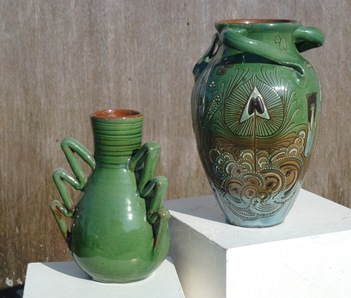 Mud to clay
Mud to clay
Picture: Two vases from the Barnstaple pottery of C H Brannam, made using brown clay from Fremington and coloured slips. The larger vessel (20 cm in height) was decorated in the Art Nouveau style by Frederick Braddon and is dated 1907. The origin of the Fremington clay deposit, a few km west of Barnstaple, has long been disputed, but it is now thought to be a Pleistocene glaciolacustrine deposit.
To the geologist, clay is a term used to describe the finest grade of clastic sedimentary particles, those less than four microns in diameter and invisible to the naked eye. In still-water depositional environments these very fine water-born particles derived from rock weathering settle out of suspension and, under appropriate conditions, may consolidate to form a mudrock. If this becomes plastic when wet, it is commonly also referred to as a clay, perhaps named after a locality, as for example the London Clay or Oxford Clay, or after its potential use, as in brick clay or china clay. Although clay minerals form the main constituent, such clays also contain quartz, feldspars, micas, calcite and iron oxides, together with many other minor components.
To the potter, clay has a much simpler definition, being a damp plastic material that sets as it dries and can be converted by heating to a hard, waterproof material. Differences in mineralogy control colour, strength, texture and firing temperature. Vessels can be moulded, built from coils or sheets, thrown on the wheel or cast. Traditionally potters would have used a locally available natural clay; but now pottery suppliers can supply clays made up to a range of recipes and the choice will depend largely on the function of the finished object. For example, the clay used to form a plant pot for outdoor use is likely to be unsuitable for an afternoon tea set and production on an industrial scale will demand a clay with different properties from that used by an individual studio potter.
There are three main types of clay available to the potter, earthenware, stoneware and porcelain. Earthenware clays range widely in appearance, from brown to white depending on composition. Brown earthenware, generally described as terracotta, is coloured by iron oxides, whereas in the preparation of the fine earthenware used to make most modern tableware great efforts are made to exclude iron from the mix. The characteristic of all earthenware is that it is fired at a temperature between 1000 and 1200ᵒC and is porous, requiring a layer of glaze to make it watertight.
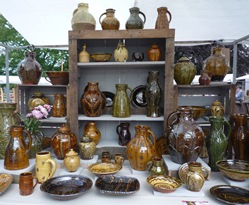
Picture: Display of slipware pottery by Doug Fitch, made with red earthenware clay using traditional slips. Clay is dug from the field behind his workshop in rural Devon. Photograph taken at Earth and Fire International Ceramics Fair, Rufford Abbey, Nottinghamshire 2014.
‘Stoneware’ describes pottery that has been fired to higher temperatures between 1200 and 1300ᵒC. At this temperature full or partial vitrification takes place, making stoneware vessels impermeable, stronger and less likely to chip than earthenware. A glaze is not essential but if applied will mature at the same time as the clay body, forming an integrated layer over the pot. ‘Porcelain’ clays are fired at even higher temperatures, between 1200 to 1400ᵒC, producing completely vitrified ware which is smooth, strong and durable.
All these clay bodies have china clay and/or ball clay as a principal component. Both clays have a large proportion of the mineral kaolinite with smaller amounts of quartz and mica. In the UK, china clay occurs as an alteration product of the Cornubian granites, from which it has been extracted for some 250 years. It is an ideal material as it withstands high temperatures while retaining its colour. Unfortunately it has low plasticity and for this reason is usually mixed with ball clay, which is similar in composition but has far higher plasticity as a result of reworking, which produces ultra-fine clay particles.
Other materials are added to the mixed clays to improve refractoriness (resistance to heat), lower the fusion point and improve density. Refractory ingredients include flint or silica sands and those that promote fusion (known as fluxes) include feldspar and china stone. The latter is a quartz/feldspar rock, whether partially kaolinised or not, free from minerals (such as biotite) which would colour the clay body. Parts of the St Austell Granite in Cornwall, which are biotite-free, were traditionally used, hence the term Cornish Stone, often found in pottery textbooks.
An idea of simple mixtures which might be used to produce the various clay bodies is shown in the table.
|
|
Earthenware
|
Stoneware
|
Porcelain
|
|
Ball Clay
|
48%
|
32%
|
|
|
China Clay
|
24%
|
32%
|
55%
|
|
China Stone (Feldspar)
|
24%
|
32%
|
(25%)
|
|
Flint
|
4%
|
4%
|
15%
|
|
Bentonite
|
|
|
5%
|
| |
|
|
|
The main differences between them are a reduction in the amount of clay, particularly ball clay, and an increase in the amount of feldspar and silica going from earthenware to porcelain. The concomitant reduction in plasticity means that porcelain is more difficult to throw and work, a problem which has been overcome in the example above by the introduction of 5% bentonite to the recipe.
Plastic
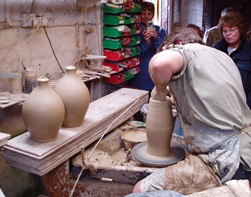 Picture: Dorset potter, Tim Hurn, throwing a stoneware bottle, with finished items.
Picture: Dorset potter, Tim Hurn, throwing a stoneware bottle, with finished items.
Immediately after it has been modelled or thrown the clay is wet and plastic and the ware produced readily deformed. Before it can be worked further it needs to be left until it is stiff, but not completely dried out, with the consistency of hard soap. In this condition, known as ‘leather hard’, it can be trimmed, handles, spouts etc. can be attached, and it can be covered with a layer of liquid clay known as ‘slip’. This slip may form a decoration in its own right, or coat the clay body to form a clean ground for painting and/or glazing, when it is called an ‘engobe’.
The ware is then left to dry out completely, when it is known as ‘green ware’, a state in which it can still be broken easily by hand and becomes plastic again if dipped in water. It is possible to directly apply glaze to green ware - known as raw glazing – but more generally items are fired to a temperature at which clays give up their combined water and some contraction takes place, but the body remains porous and will absorb water. This unglazed fired ware is known as ‘biscuit’ or ‘bisque’ and the temperature at which it is fired is related to the clay used and production methods.
On firing green earthenware most water has been driven off by 350ᵒC but vapour may still be detected up until 900ᵒC and carbonaceous material and other volatiles can remain up to 1100ᵒC or even higher. If the biscuit ware is refired to a higher temperature than its first firing, the body will continue to react, liberating gases which, if the pot has been glazed, have to bubble through the glaze layer.
Picture: Salt-glazed articulated jug, held by its maker Walter Keeler, based in Monmouthshire. The lower part has been dipped in a china clay/feldspar slip to create a contrasting surface.
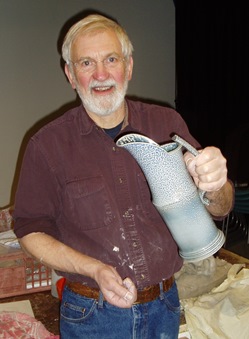 Most industrial pottery is earthenware and in order to obtain a smooth glaze finish, it is beneficial for the glaze firing to take place at a temperature lower than the bisque firing in order to prevent further decomposition and gas release causing blemishes on the glaze. Thus the industrial potter bisque fires earthenware to say 1150ᵒC and then uses glazes that demand a lower firing temperature of about 1060ᵒC.
Most industrial pottery is earthenware and in order to obtain a smooth glaze finish, it is beneficial for the glaze firing to take place at a temperature lower than the bisque firing in order to prevent further decomposition and gas release causing blemishes on the glaze. Thus the industrial potter bisque fires earthenware to say 1150ᵒC and then uses glazes that demand a lower firing temperature of about 1060ᵒC.
However, higher bisque temperatures reduce the porosity of the ware and most craft potters adopt a different strategy, bisque firing to around 1000ᵒC for earthenware, stoneware and porcelain. Blemishes are healed by holding the final glaze firing temperature for 30 minutes or more, a process known as soaking.
Decorating
Decorating and glazing are generally regarded as the most difficult and unpredictable parts of ceramic production, but it is where an understanding of petrology and geochemistry proves most useful.
Glazing essentially involves putting a coating of glass on pottery, and glazes are based on three main components, glass-formers, fluxes and stabilisers. The most important glass-former is silica, which can be added directly as flint or quartz, or indirectly as a component of silicate minerals such as clays, feldspars, and wollastonite. Fluxes cause the other components to melt or flow and one of the most widely used is lead oxide. However, above about 1180ᵒC lead increasingly vaporises which means that it can be used only in earthenware glazes.
Other commonly used fluxes are potassium and sodium oxides, usually provided by adding feldspars, and calcium and magnesium oxides derived from limestone, chalk and dolomite. Stabilisers reduce the fluidity of the glaze and deter devitrification. The main stabiliser used is alumina, introduced into the glaze mix in clay minerals or feldspar. In addition to these three principal components glazes may also contain colouring pigments derived from metals, such as copper, iron, cobalt and manganese. These can be used singly or in combination to obtain a variety of colours which can vary depending on firing conditions in the kiln.
For example, iron oxides might produce a warm brown in oxidising conditions and greens under reduction. Bernard Leach referred to the glass-formers as the ‘bone’ of a glaze, fluxes as their ‘life blood’, with stabilisers and other less-easily defined elements as the ‘flesh’ of a glaze. It is the juggling of the percentages of these three main components, and the skilful deployment of colouring oxides, which control the end product.
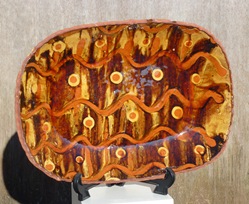 Glazes
Glazes
Picture: Slipware bowl by Devon potter, Doug Fitch, made of red earthenware clay using a mold and decorated by slips using locally-sourced clays.
Glazes are applied by mixing the mineral powders with water to the consistency of a thin cream and then dipping the bisque-fired ware in a bucket of glaze or by brushing or spraying. The powders need to be finely milled so that they can be kept easily in suspension. It is also possible to glaze pots within the kiln during the firing process. The most common example is the ‘salt glazing’ of stoneware, where salt is introduced into the kiln when temperatures reach about 1100ᵒC. The salt volatilises to hydrochloric acid and sodium oxide. The acid is lost from the kiln and the sodium oxide reacts with pot surfaces, producing a skin of sodium aluminium silicate. The orange-peel effect obtained is extremely attractive and colouring oxides can be applied to give a range of colours.
As well as colouring glazes, metal pigments can be used to decorate ware either over or under the glaze. A wide range of colours is now available, but at stoneware and porcelain firing temperatures many of these colours tend to vaporise and are suitable only for earthenware. With stoneware the clay body and glaze form an integrated layer and the quality and colour of the glaze are derived partly from the body beneath. In consequence iron particles in the body will show up as brown specks through the glaze and the resulting colour range tends to be more muted than that of earthenware.
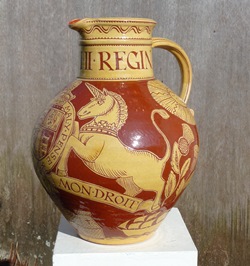 Picture: Modern North Devon harvest jug by Harry Juniper of Bideford. The pot is covered with a white slip and the design is made by scratching through the slip to expose the contrasting red body – a technique known as scraffito.
Picture: Modern North Devon harvest jug by Harry Juniper of Bideford. The pot is covered with a white slip and the design is made by scratching through the slip to expose the contrasting red body – a technique known as scraffito.
It is possible to use materials apart from rocks and minerals in glazes. The most common are calcined animal bone, used as an opacifier, and wood ash. The latter contains fluxes in varying proportions - soda, potash, lime and magnesia, occurring as phosphates, sulphates and chlorides, which are readily broken down. There is also some alumina and silica so that the wood ash is capable by itself of glazing pottery. In practice it is too fluid, runs off the pot and needs to be combined with feldspar or clay. A simple mixture of 40% wood ash, 40% potash feldspar and 20% ball clay makes an effective glaze mixture and by replacing all or part of the ball clay with a local alluvial clay or by ground Ordovician slate from one of the Cumbrian quarries, I have produced a variety of colours and finishes, firing under reducing conditions. If the kiln is wood-fired, interesting effects can also be obtained by allowing wood ash to settle on pots in the kiln during the firing process.
Reducing
My own practice involves firing functional stoneware pots, under reducing conditions, using a gas-fired kiln. Although it is possible to generate reducing atmospheres in an electric kiln, this is not a trivial task and such atmospheres are most easily generated in kilns fired by solid fuels, oil or gas, by reducing the amount of air to less than that required for full combustion. Inadequate combustion results in the formation of carbon (black smoke coming out of the kiln chimney) and carbon monoxide. At the high temperatures present in the kiln these are chemically active, seeking oxygen from any available host, including the metal oxides in clay bodies and glazes. As a consequence copper, added to the glaze mix as the carbonate, produces a red colour instead of green, and red iron oxide, as hematite, will give greys and blacks as it is reduced to magnetite, under the right conditions yielding the luscious black glaze, which breaks to rusty brown on the edges, known as ‘tenmoku’. Small amounts of iron will produce the green tints, from pale green to dark olive, known as ‘celadon’, named after the hero in d’Urfé’s 17th Century French pastoral romance L’Astrée, who wore clothes of this colour.
Leach tradition
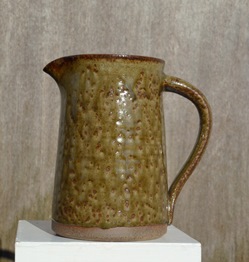 Picture: Jug with wood ash glaze (40% wood ash, 40% potash feldspar, 20% powdered Ordovician slate from Honister, Cumbria). Made by the author.
Picture: Jug with wood ash glaze (40% wood ash, 40% potash feldspar, 20% powdered Ordovician slate from Honister, Cumbria). Made by the author.
Most of my pottery belongs to what has become known as the Leach tradition. Bernard Leach (1887-1979) was born in Hong Kong and spent much of his youth in the Far East. He established a pottery at St. Ives in Cornwall in 1920 and was heavily influenced by Chinese stoneware and Japanese ceramics. Assisted by his son David (1911-2005), the standard ware which the pottery developed rejected highly decorated crockery with its impractical handles and produced a stoneware range, combining traditional forms and modern materials, with minimal decoration and celadon and tenmoku glazes.
Making up one’s own glazes and using them to decorate simple, practical and functional pots is extremely satisfying. The minerals and rocks used in the preparation of clays and the generation of glazes (melts), such as kaolinite, potash feldspar, flint and limestone are all well known and the geologist starts with an inbuilt advantage when experimenting with ceramic materials and trying to understand how they might combine and interact.
Being able to produce an attractive object from a lump of wet clay and a selection of mineral and rock powders is an enviable skill, one I might have been able to achieve if I had started 50 years ago instead of 10!
Further reading
- Adams, P J 1961 Geology and ceramics. HMSO, London.
- Billingham, Dora M 1962 The technique of pottery. Batsford, London.
- Fraser, Harry 1998 Glazes for the craft potter. Revised edition. A & C Black, London.
- Leach, Bernard 1990 A potter’s book. Faber & Faber, London.